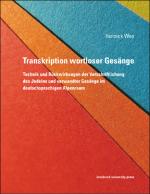Transkription wortloser Gesänge
Technik und Rückwirkungen der Verschriftlichung des Jodelns und verwandter Gesänge im deutschsprachigen Alpenraum
| dc.contributor.author | Wey, Yannick | |
| dc.date.accessioned | 2020-06-16T12:42:43Z | |
| dc.date.available | 2020-06-16T12:42:43Z | |
| dc.date.issued | 2019 | |
| dc.identifier | ONIX_20200616_9783903187818_19 | |
| dc.identifier | OCN: 1253402972 | |
| dc.identifier.uri | http://library.oapen.org/handle/20.500.12657/39645 | |
| dc.language | German | |
| dc.relation.ispartofseries | Thesis series | |
| dc.subject.classification | thema EDItEUR::A The Arts::AV Music::AVA Theory of music and musicology | en_US |
| dc.subject.classification | thema EDItEUR::J Society and Social Sciences::JH Sociology and anthropology::JHM Anthropology::JHMC Social and cultural anthropology | en_US |
| dc.subject.other | Alps | |
| dc.subject.other | Yodeling | |
| dc.subject.other | Literality | |
| dc.subject.other | Transcription | |
| dc.subject.other | Alpen | |
| dc.subject.other | Jodeln | |
| dc.subject.other | Schriftlichkeit | |
| dc.subject.other | Transkription | |
| dc.title | Transkription wortloser Gesänge | |
| dc.title.alternative | Technik und Rückwirkungen der Verschriftlichung des Jodelns und verwandter Gesänge im deutschsprachigen Alpenraum | |
| dc.type | book | |
| oapen.abstract.otherlanguage | Since the beginning of the 19th century, orally transmitted songs in the Alpine region have been increasingly transcribed into music notation. The translation of sound into writing poses an essential problem of ethnomusicology; here we can study this process in a field that is clearly defined and delimited and has experienced many different forms of music transcription over a period of more than two centuries. The present research results provide insight into the processes by which wordless singing in the German-speaking Alpine region was transcribed and how the results affected musical traditions. Characteristics of alpine yodeling and related singing styles came under the influence of norms of notation-based music, in particular diatonic scales and the formal characteristics of written songs. Music notation functions as a transformative technology, which helps to shape the content and form of music and leads to new possibilities as well as to limitations in the presentation and storage of musical content. - Seit dem Beginn des 19. Jahrhunderts wurden mündlich tradierte Gesangsgattungen im Alpenraum zunehmend musikalisch transkribiert. Die Übersetzung des Klangs in Schrift, eine wesentliche Thematik der Musikethnologie, kann hier in einem Feld beobachtet werden, das klar definiert und abgegrenzt wird und diesen Prozess der Verschriftlichung über rund zwei Jahrhunderte in vielfältigen Ausprägungen erlebte. Die vorliegenden Forschungsresultate geben Einsicht in die Prozesse, durch welche der wortlose Gesang im deutschsprachigen Alpenraum verschriftlicht wurde, und die daraus erfolgten Rückwirkungen auf die musikalische Tradierung. Merkmale des alpenländischen Jodlers und verwandter Gesangsstile wurden von den Normen der schriftbasierten Musik, im Speziellen von diatonischen Tonskalen und den formalen Eigenschaften von Liedern, überlagert. Musiknotation funktioniert hierbei als transformative Technologie, welche den Inhalt und die Form der Musik mitgestaltet und sowohl zu neuen Möglichkeiten als auch zu Einschränkungen in der Darstellung und Speicherung musikalischer Inhalte führt. | |
| oapen.relation.isPublishedBy | 7e4aa047-ebd5-4269-b6c8-a86925324b93 | |
| oapen.collection | AG Universitätsverlage | |
| oapen.pages | 364 | |
| oapen.place.publication | Innsbruck | |
| oapen.remark.public | 21-7-2020 - No DOI registered in CrossRef for ISBN 9783903187818 |

